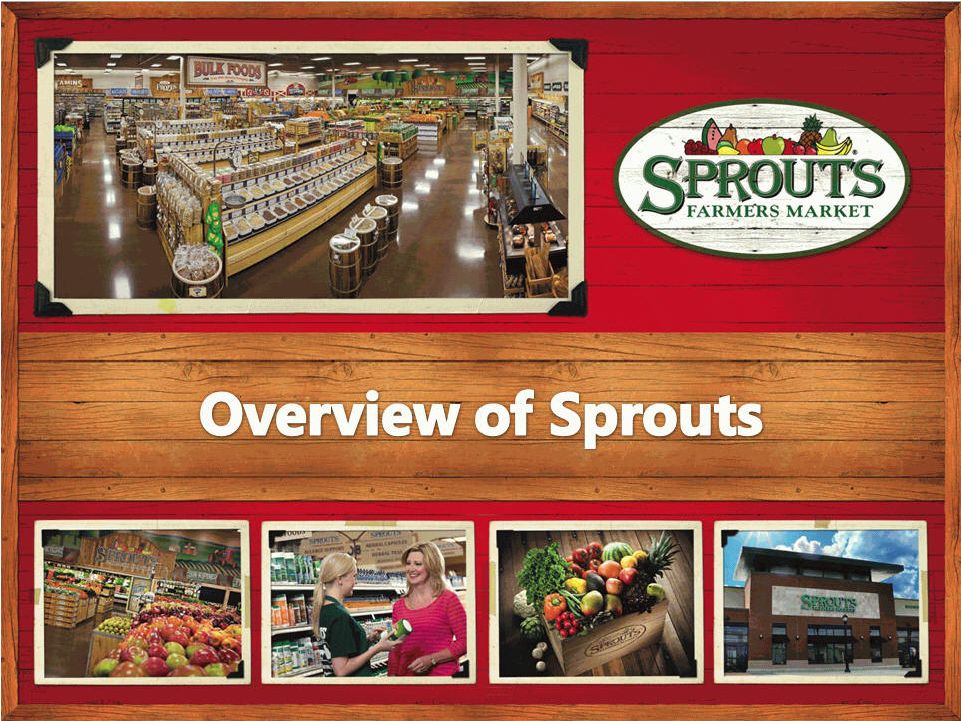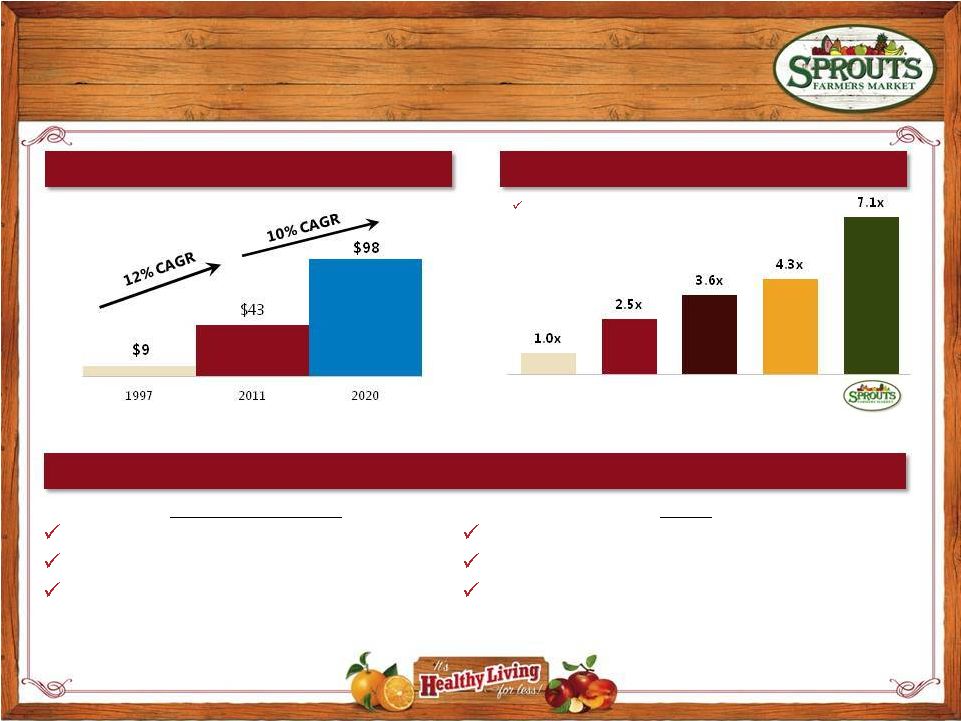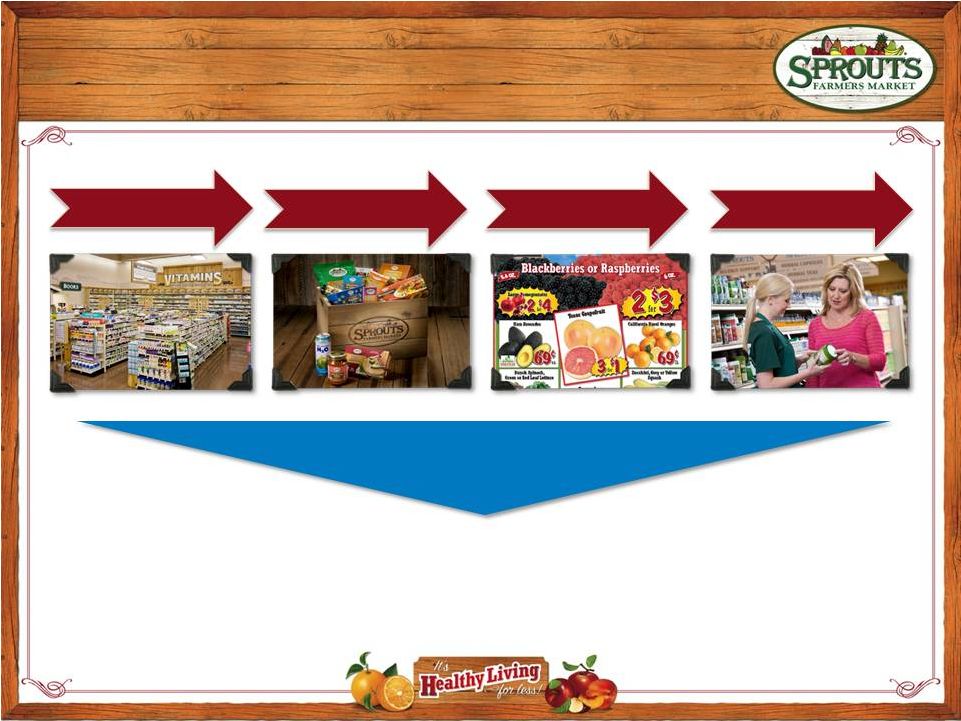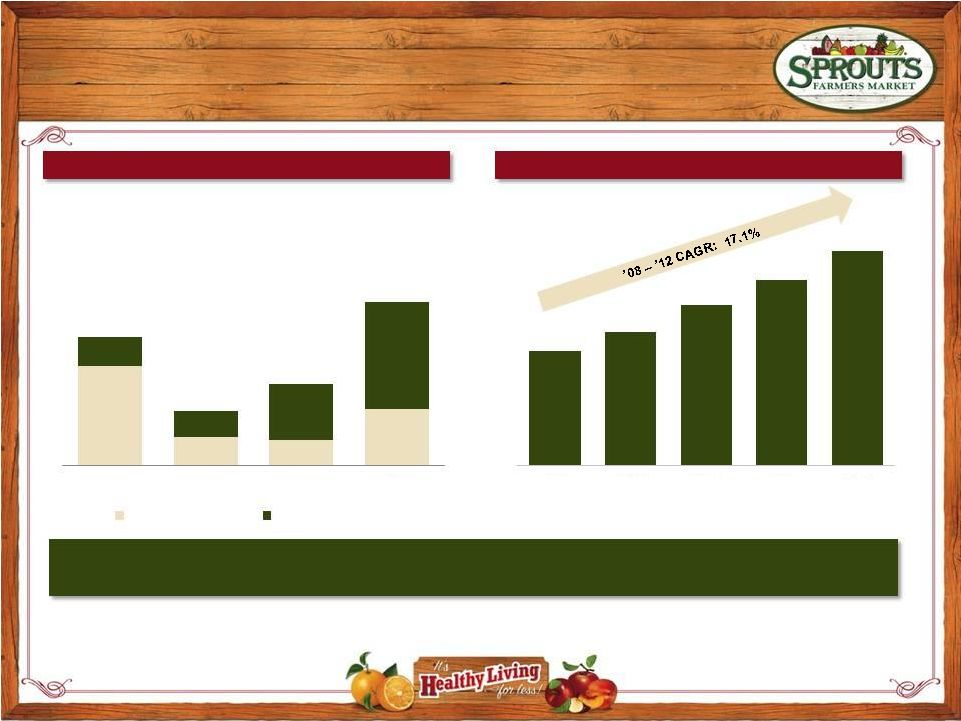Attached files
| file | filename |
|---|---|
| 8-K - FORM 8-K - Sprouts Farmers Market, Inc. | d637710d8k.htm |
 Investor Deck
Investor Deck
Exhibit 99.1 |
 Forward-Looking Statements and Non-
Forward-Looking Statements and Non-
GAAP Financial Measures
GAAP Financial Measures
1
Certain statements in this presentation are forward-looking as defined in the Private Securities
Litigation Reform Act of 1995. Any statements contained herein (including, but not limited to,
statements to the effect that Sprouts Farmers Market, Inc. (the “Company”)or its management
"anticipates," "plans," "estimates," "expects," "believes," or
the negative of these terms and other similar expressions) that are not statements of
historical fact should be considered forward-looking statements. These statements involve certain risks and uncertainties that may cause
actual results to differ materially from expectations as of the date of this presentation. These risks
and uncertainties include, without limitation, risks associated with the Company’s ability
to successfully compete in its intensely competitive industry; the Company’s ability to successfully
open new stores; the Company’s ability to manage its rapid growth; the Company’s ability to
maintain or improve its operating margins; the Company’s ability to identify and react to
trends in consumer preferences; product supply disruptions; general economic conditions; and other
factors as set forth from time to time in the Company’s Securities and Exchange Commission
filings. The Company intends these forward- looking statements to speak only as of the date
of this presentation and does not undertake to update or revise them as more information
becomes available, except as required by law.
In addition to reporting financial results in accordance with GAAP, the Company has presented adjusted
net income, adjusted diluted earnings per share and adjusted EBITDA. These measures are not in
accordance with, or an alternative to GAAP. The Company's management believes that these
presentations provide useful information to management, analysts and investors regarding certain additional financial and
business trends relating to its results of operations and financial condition. In addition, management
uses these measures for reviewing the financial results of the Company as well as a component
of incentive compensation. The Company defines adjusted net income as net income excluding
store closure and exit costs, one-time costs associated with its April 2011 combination (the “Henry’s Transaction”) with
Henry’s Holdings, LLC (“Henry’s”) and its May 2012 business combination with
Sunflower Farmers Market, Inc. (the “Sunflower Transaction,” and together with the
Henry’s Transaction, the “Transactions”), gain and losses from disposal of assets, the loss on extinguishment of debt
and the related tax impact of those adjustments. The Company defines adjusted diluted earnings per
share as adjusted net income divided by the weighted average diluted shares outstanding. The
Company defines EBITDA as net income before interest expense, provision for income tax, and
depreciation and amortization, and defines adjusted EBITDA as EBITDA excluding store closure and exit costs, one-time costs
associated with the Transactions, gains and losses from disposal of assets and the loss on
extinguishment of debt. These non-GAAP measures are intended to provide additional
information only and do not have any standard meanings prescribed by GAAP. Use of these terms
may differ from similar measures reported by other companies. Because of their limitations, none of these non-GAAP measures should
be considered as a measure of discretionary cash available to use to reinvest in growth of the
Company’s business, or as a measure of cash that will be available to meet the
Company’s obligations. Each of these non-GAAP measures has its limitations as an analytical tool, and you
should not consider them in isolation or as a substitute for analysis of the Company’s results as
reported under GAAP. See the Appendix for reconciliation for these non-GAAP measure to the
comparable GAAP measures. In addition, in comparing its results to the comparable periods of 2012, the Company has presented
2012 financial results on a pro forma basis as if the Sunflower Transaction had occurred on the
first day of the Company’s 2012 fiscal year. See the Appendix for unaudited
supplemental pro forma condensed consolidated financial information.
|
 2
|
 Benefitting from Long-Term Macro Trends
Benefitting from Long-Term Macro Trends
Sprouts growing at 7x U.S.
Supermarkets
2008-2012
CAGR:
2.4%
6.1%
8.6%
10.3%
17.1%
U.S.
Supermarkets
Vitamins &
Supplements
Natural &
Organic
Value
Health & Wellness
Greater focus on preventative health
Childhood obesity
Specialty diets (e.g., gluten-free)
Value
Increasingly cost-conscious consumers
Persistent shift in shopping behaviors
Sprouts makes healthy choices affordable
¹
Source: Nutrition Business Journal.
²
Chart
data
represents
the
multiple
of
average
annual
U.S.
Grocery
sales
growth
(“CAGR”)
from
2008
through
2012
for
each
respective
category
or
entity.
Value
segment
defined
as
dollar
stores
(Dollar
General, Dollar Tree, Family Dollar). Source: Progressive Grocer (U.S.
Supermarket Industry), Nutrition Business Journal (Vitamins & Supplements; Natural & Organic), and company filings (Value).
3
$600B U.S. Supermarket Industry
Natural & Organic Sales Projected to Grow
by 10% Annually Through 2020
Strong
Market
Opportunity
1
Sprouts
is
Outpacing
Relevant
Segments
2
Supported by Strong Macro Tailwinds |
 Sprouts has a Differentiated
Sprouts has a Differentiated
Go-to-Market Strategy
Go-to-Market Strategy
Complete Natural &
Organic Offering
4
HEALTH
HEALTH
SELECTION
SELECTION
VALUE
VALUE
SERVICE
SERVICE
An Engaged, Loyal Customer Base Leading to Strong Financial
Performance and Significant New Unit Growth Opportunity
|
 Sprouts “Flips”
Sprouts “Flips”
the Conventional
the Conventional
Grocery Store Model
Grocery Store Model
Produce surrounded by
a complete grocery
offering
Differentiated
assortment of high-
quality, healthy
alternatives
Farmers market
inspired, open store
layout with low profile
displays
Convenient,
small-box:
25 –
28k sq. ft.
Comfortable, easy to
shop environment
Full grocery store
5 |
 6
Produce is a common denominator among
customers
Supply chain system scalable to support growth
Focus on freshness, speed-to-market and value
Prices significantly below competitors drive trial
and traffic
6
Fresh Produce is at the Core of Sprouts’
Fresh Produce is at the Core of Sprouts’
Offering
Offering
Current Produce Distribution Centers
Produce
Sourced and Distributed
In-House
Local Sourcing,
Deep Industry Relationships
Regional Buying Model
Limited CapEx Required for
New Distribution
Centers |
 Reaching a Broad Base of Consumers in
Reaching a Broad Base of Consumers in
Both Traditional and Digital Mediums
Both Traditional and Digital Mediums
More than 10 million weekly circulars
Reinforces value offering
25+
annual
department
promotions
1
, which drive
transition to increased basket size and higher
margin
Digital platform for relevance today and tomorrow
¹
Represents planned promotions at each store during FY 2013.
7
7 |
 Sprouts Targets the Conventional
Sprouts Targets the Conventional
Supermarket Customer
Supermarket Customer
Middle income and up
Educated
Wide spectrum of demographic and
ethnic makeups
Wanting to eat healthier, but not sure
how
Looking for value
Broad Customer Demographics
Densely populated, urban areas as well
as smaller metropolitan markets
•
Los Angeles and El Paso
“Natural / lifestyle”
markets and more
“traditional”
states
•
Colorado and Oklahoma
Successful in new as well as highly
competitive and penetrated markets
Draw Traffic in Variety of Markets
Sprouts
Proves That
Eating Healthy
Can Be
Affordable.
8 |
 Lifestyle
Lifestyle
Transition
Transition
Trial
Trial
Sprouts Grows its Share of Consumers’
Sprouts Grows its Share of Consumers’
“Food Retail Wallet”
“Food Retail Wallet”
Consumers Start with High Quality
Produce
Over Time Make Sprouts Their Primary
Grocery Store
Then Begin Shopping in an Increasing
Number of Departments
9
Increasing Average Basket Size and Gross Margin Over Time
|
 Estimated 15+ Years of New Store
Estimated 15+ Years of New Store
Growth
Growth
Potential U.S. Store Count¹
1 Based on an assumed new store growth rate of 12% per year and research
conducted by Buxton Company in 2012. Proven Concept: 167 stores in eight
states Strong performance across all markets, demographics and real estate
venues Opened 19 stores in 2013 with 12% unit growth going forward
Demographics allow for deep penetration in markets
10
300
in
Existing
Markets
~1,200
7.2x
1.8x
167
Mississippi
Washington
Oregon
Nevada
Utah
Colorado
New
Mexico
Arizona
California
Oklahoma
Texas
Louisiana
Arkansas
Missouri
Kansas
Tennessee
North
Carolina
Georgia
South
Carolina
Alabama
Florida
2
73
26
3
24
6
4
29
Existing Market
Target Near Term New Market |
 Sprouts’
Sprouts’
Consistent Growth in
Consistent Growth in
Competitive Markets
Competitive Markets
11
Case Study of a Sprouts Phoenix Location
Broad Appeal Makes Sprouts a Formidable Competitor
1 Not indicative of every store location.
Whole Foods
opened 2002
Wal-Mart
opened
Trader Joe’s
opened
Frys
Marketplace
re-opened
Target added
P-Fresh
Costco
opened
+1%
+15%
+30%
+11%
+3%
+7%
+7%
+4%
+7%
2004
2005
2006
2007
2008
2009
2010
2011
2012
2013 YTD
($ in ‘000s) |
 Why
Sprouts is a Compelling Investment Why Sprouts is a Compelling Investment
Authentic Natural and Organic Food Offering at
Great Value
Fast Growing Segment of the U.S. Supermarket
Industry with Strong Macro Tailwinds
Significant New Store Growth Opportunity
Supported by Broad Demographic Appeal
Proven and Replicable Store Model with
Compelling Unit Economics
Resilient Business Model
Delivering Strong
Financial Performance and Strong Comparable
Store Sales Growth
Passionate Management Team with a Customer
Focused Culture
12 |
 Business & Financial
Performance
13 |
 A
Powerful Long-Term Growth Engine A Powerful Long-Term Growth
Engine High, balanced sales growth
Margin expansion in existing stores
Operating leverage from scale and infrastructure
Deleverage capital structure
14
Long-Term Net Earnings Growth
Target of 20%+
10%+
Natural /
Organic Sector
Growth
Consistent Store
Performance
Across
Geographies
and Vintages
Comp Growth
and Margin
Expansion in
Existing Stores
Compelling
Store-Level
Economics
One of the Best
White Space
Opportunities
in the Public
Markets
Leverage
Infrastructure
for Scale and
Growth |
 History of Organic Growth
History of Organic Growth
Balanced Sales Growth Across Comparable Store Sales Growth and New Store
Openings ($ in mm)
15
$1,059
$1,239
$1,490
$1,723
$1,991
2008
2009
2010
2011
2012
2.6%
2.3%
5.1%
9.7%
11.6%
4.9%
7.4%
14.8%
2009
2010
2011
2012
Prior Period
Current Period
¹ “Comparable store sales growth” refers to the percentage change in our
comparable store sales as compared to the prior comparable period. Pro forma comparable store sales growth reflects
comparable store sales growth calculated as if the Henry’s Transaction and the Sunflower
Transaction had been consummated on the first day of fiscal 2007. Comparable store sales growth on a “two-
year stacked basis” is computed by adding the pro forma comparable store sales growth of the
period referenced and that of the same fiscal period ended twelve months prior. ² Pro
forma net sales reflect the net sales of our predecessor entity and Sunflower as if the Henry’s Transaction and Sunflower Transaction had been consummated on the first day of fiscal 2008.
Pro Forma Comparable Store Sales Growth
Pro Forma Net Sales
1
2 |
 Compelling Unit Economics
Compelling Unit Economics
Includes store build-out (net of contributions from landlords), inventory
(net of payables) and cash pre-opening expenses. Store Size
25 –
28k sq. ft.
Net
Cash
Investment
1
$2.8 million
First Year Sales
~$10 –
$12 million
Initial Sales Growth
20-30% over 3 –
4 years
16
Target New Store Economics
Pre-Tax Cash-on-Cash Returns
35%-40% within 3-4 years
1 |
 Momentum
Momentum
Continued through Q3
Continued through Q3
1
Net sales for 2012 YTD are pro forma net sales, reflecting the net sales of
Sunflower as if the Sunflower Transaction had been consummated on the first day of fiscal 2012.
2
“Comparable store sales growth”
refers to the percentage change in our comparable store sales as compared to the
prior comparable period. Pro forma comparable store sales growth reflects
comparable
store
sales
growth
calculated
as
if
the
Sunflower
Transaction
had
been
consummated
on
the
first
day
of
fiscal
2012.
Comparable
store
sales
growth
on
a
“two-year
stacked
basis”
is
computed
by
adding
the
pro
forma
comparable
store
sales
growth
of
the
period
referenced
and
that
of
the
same
fiscal
period
ended
twelve
months
prior.
($ in mm)
Opened 7 new stores, met annual target of 19 openings
Over 24% net sales growth in Q3 compared to 2012
Continued double-digit comp growth on a 1-year and 2-year stacked
basis 17
Highlights
Net Sales
Pro Forma Comparable Store Sales Growth²
|
 Robust Earnings Growth
Robust Earnings Growth
Adj. EBITDA¹
Adj. Net Income²
($ in mm)
($ in mm)
% Margin
6.3%
8.3%
18
Note:
Financial
information
on
this
slide
for
fiscal
2012
gives
pro
forma
effect
to
the
Sunflower
Transaction
as
if
it
had
been
consummated
on
the
first
day
of
fiscal
2012.
¹
See the Appendix to this presentation for a reconciliation of adjusted EBTIDA to net
income. ²
See the Appendix to this presentation for a reconciliation of adjusted net income to
net income. $7.5
$19.5
2012 Q3
2013 Q3
$32.2
$52.6
2012 Q3
2013 Q3 |
 Strong Balance Sheet and Liquidity
Strong Balance Sheet and Liquidity
¹
Represents
the
midpoint
of
estimated
capital
expenditures
range
of
$70mm to $75mm for 2013, net of estimated landlord tenant improvement allowances of
$11mm. New store capital expenditures calculated as typical store buildout
(net of contributions from landlords) of approximately $2.4mm multiplied by the 19 stores expected to be opened in 2013.
Ample liquidity going forward
supported by $60mm undrawn
revolver and $92mm of cash on hand
Solid free cash flow generation with
ability to self-fund organic growth
Capitalization
At Sep. 29,
2013
Revolver ($60mm)
$0
Term Loan
360
Capital and Financing Leases
120
Total Debt
$480
Cash
92
Net Debt
$388
Net Debt /
LTM Q3 2013 Adj. EBITDA
2.1x
19
•
$143mm 2013 YTD operating cash
flow
•
$73mm
2013E
capital
expenditures
1
•
Generate significant free cash flow
after investing in new stores and
infrastructure |
 2013
Financial Targets 2013 Financial Targets
Unit Growth
19 New Stores
Comparable Store Sales Growth
9.0% -
9.5%
Total Sales Growth
20% -
21%
Adjusted EBITDA
$188M -
$192M
Adjusted Net Income
$63M -
$65M
Adjusted Diluted EPS
$0.45 -
$0.46
Capital Expenditures (net of landlord reimbursements)
$70M -
$75M
20 |
 Long-Term Financial Targets
Long-Term Financial Targets
Unit Growth
~12%
Comparable Store Sales Growth
6%+
Total Sales Growth
~15%
EBIT Growth
17-20%
Net Income Growth
20%+
21 |
 Conclusion and Q&A
Conclusion and Q&A
Authentic Natural and Organic Food Offering at
Great Value
Fast Growing Segment of the U.S. Supermarket
Industry with Strong Macro Tailwinds
Significant New Store Growth Opportunity
Supported by Broad Demographic Appeal
Proven and Replicable Store Model with
Compelling
Unit
Economics
Resilient
Business
Model
Delivering Strong
Financial Performance and Strong Comparable
Store Sales Growth
Passionate Management Team with Customer
Focused Culture
22
Significantly lower prices
Significantly lower prices
10% CAGR to $98B in
2020
10% CAGR to $98B in
2020
1,200 potential stores
(7.2x current base)
1,200 potential stores
(7.2x current base)
Target 35-40% cash-on-
cash returns
Target 35-40% cash-on-
cash returns
20% 2-year comps
20% 2-year comps |
 Appendix: Supplemental
Appendix: Supplemental
Materials
Materials
23 |
 Non-GAAP Reconciliation
Non-GAAP Reconciliation
24
(a)
See “Unaudited Supplemental Pro Forma Condensed Consolidated
Financial Information” for a reconciliation of pro forma
net income to net income for the thirteen and thirty-nine
weeks ended September 30, 2012. (b)
adjusted EBITDA, and from adjusted and pro forma adjusted net income.
In fiscal 2013 these costs included the costs related to the
closure of a former Sunflower warehouse facility and adjustments
to sublease assumptions on other properties. In fiscal 2012
these consist primarily of the costs to close a Sunflower
administrative facility following the Sunflower
Transaction. (c)
integrate the combined businesses resulting from the Sunflower and
Henry’s Transactions. These expenses include professional
fees and severance, which the Company excludes from its pro
forma adjusted EBITDA and pro forma adjusted net income to
provide period-to-period comparability of the Company’s operating results
because management believes these costs do not directly reflect the
ongoing performance of its store operations. The Company
does not expect to incur material expenses associated with
integration of the Sunflower and Henry’s Transactions in fiscal
2013.
(d)
connection with the disposal of property and equipment. The
Company excludes gains and losses on disposals of assets from
its adjusted and pro forma adjusted EBITDA and adjusted and pro
forma adjusted net income to provide period-to-period comparability of
its operating results because management believes these costs do not
directly reflect the ongoing performance of its store
operations. The loss recorded in fiscal 2012 primarily relates
to the loss on the sale leaseback of a store property. (e)
presented represents the income tax provision and pro forma income tax
provision plus the tax effect of the adjustments described in
notes (b) through (e) above based on statutory tax rates for the
period. For the thirty-nine weeks ended September 30, 2012,
this amount was further adjusted to reflect a $1.8 million reduction in
pro forma income tax provision for the effects of certain items
related to the Sunflower Transaction. Of the adjustment, $2.2
million relates to the tax effects of $3.3 million and $2.9 million of
non-deductible transaction costs incurred by the Company and
Sunflower, respectively, based on statutory tax rates for the
period. This adjustment was partially offset by a $0.4 million
adjustment related to tax benefits from Sunflower stock option exercises. The
Company has excluded these items from its pro forma adjusted income tax
provision because management believes they do not directly
reflect the ongoing performance of its store operations and are
not reflective of its ongoing income tax provision.
Store
closure
and
exit
costs
have
been
excluded
from
adjusted
and
pro
forma
Costs
associated
with
acquisitions
and
integration
represent
the
costs
to
Gain/Loss
on
disposal
of
assets
represents
the
gains
and
losses
recorded
in
Pro
forma
adjusted
and
adjusted
income
tax
provision
for
all
periods |
 Pro
Forma Reconciliation Pro Forma Reconciliation
25
SPROUTS FARMERS MARKET, INC.
UNAUDITED PRO FORMA CONDENSED CONSOLIDATED STATEMENT OF OPERATIONS
For the Thirteen Weeks Ended
September 30, 2012 (in thousands,
except per share amounts) |
 Pro
Forma Reconciliation Pro Forma Reconciliation
26
SPROUTS FARMERS MARKET, INC.
UNAUDITED PRO FORMA CONDENSED CONSOLIDATED STATEMENT OF OPERATIONS
For the Thirty-nine Weeks
Ended September 30, 2012
(in thousands, except per share amounts) |
 Pro
Forma Reconciliation Pro Forma Reconciliation
27
SPROUTS FARMERS MARKET, INC.
NOTES TO UNAUDITED PRO FORMA CONDENSED CONSOLIDATED FINANCIAL
INFORMATION 1. Basis of Presentation and Description of
Transactions Effective May 29, 2012, the Company acquired
all of the outstanding common and preferred stock of Sunflower in the Sunflower
Transaction, a transaction accounted for as a business combination,
which was financed through the issuance of debt and 14.9 million shares of
common stock.
The historical Sprouts Farmers Market, Inc. results of operations for
the thirteen and thirty-nine weeks ended September 30, 2012 are
derived from its unaudited consolidated financial statements for the
periods then ended. The historical Sunflower results of operations for the
period January 1, 2012 to May 28, 2012, were derived from the
Sunflower pre-combination unaudited financial statements. Certain amounts from
the Sunflower pre-combination unaudited financial statements have
been reclassified to conform to the Company’s presentation.
2. Pro Forma for Sunflower Transaction
The historical results of operations have been adjusted to give pro
forma effect to events that are (i) directly attributable to the
Sunflower Transaction, (ii) factually supportable and (iii) expected
to have a continuing impact on the combined results, as if the Sunflower
Transaction occurred on the first day of fiscal 2012 (referred to as
“Pro Forma Adjustments for Sunflower Transaction”). Below is a description
of the types of adjustments represented in the Sunflower Fiscal Period
Alignment and Sunflower Transaction Adjustments columns.
Sunflower Fiscal Period Alignment - Sunflower’s fiscal 2012
commenced one day earlier than the Company’s fiscal 2012. Pro forma
adjustments for Sunflower Fiscal Period Alignment reflect the pro
forma impact of deducting one day from the historical Sunflower results of
operations.
Cost of Sales, Buying and Occupancy – Adjustments attributable to
the application of acquisition accounting including straight-line rent
adjustments and adjustments to the amortization of favorable lease
intangible assets and unfavorable lease liabilities. Direct
Store Expenses – Adjustments to historical Sunflower depreciation related to changes in value and estimated useful lives of
property plant and equipment.
Selling, General and Administrative Expenses – Adjustments
related to Sunflower Transaction fees recorded by both Sprouts and
Sunflower, accelerated share-based compensation recorded by
Sunflower, adjustments to depreciation related to changes in value and estimated
useful lives of property, plant and equipment and amortization of the
Sunflower trade name. Interest Expense – Adjustments
related to the reversal of historical Sunflower interest expense, incremental interest expense related to
the proceeds from additional term loan and senior subordinated notes
that were used to effectuate the transaction and interest related to Sunflower
capital and financing lease obligations.
Income Tax Provision – Adjustment to the income tax provision for
the items listed above. Net income per share – Net income
per share has been adjusted to reflect those items listed above and the change in weighted average
shares outstanding – basic and diluted as described below.
Weighted average shares outstanding – basic and diluted –
The weighted average shares outstanding basic and diluted have been
adjusted for the effect of the additional shares issued in the
Sunflower Transaction. |
 |
